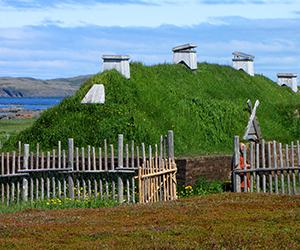CANADA HISTORY - Places-Religious
Doukhobor Village Museum

The Doukhobor Discovery Centre, located in the Kootenay region of British Columbia, offers a deep dive into the unique history and culture of the Doukhobor people, religious dissenters from Russia who settled in Canada in the late 19th and early 20th centuries. The center recreates the communal village life of the Doukhobors, a group that carved out a distinct cultural and spiritual identity during their time in British Columbia. This essay will explore the origins of the Doukhobor movement, the factors that led to their exodus from Russia, the role of figures such as Leo Tolstoy in facilitating their journey, and the significance of the Doukhobor Discovery Centre in preserving their heritage.
Origins of the Doukhobor Movement
The Doukhobors originated in Russia during the 18th century as a pacifist Christian sect that rejected the authority of the Russian Orthodox Church and the state. Their name, derived from the Russian term “Dukhobortsy,” meaning "Spirit Wrestlers," reflected their belief in the inner spirit of God within every person and their resistance to external religious rituals and hierarchies. Doukhobors emphasized nonviolence, communal living, and the rejection of materialism, often clashing with the autocratic Russian government and the Orthodox Church.
By the 19th century, the Russian state had grown increasingly hostile toward the Doukhobors, particularly after they refused to serve in the military, which conflicted with their pacifist principles. This resistance led to persecution, imprisonment, and exile to remote parts of Russia. However, the Doukhobors’ plight attracted the attention of notable intellectuals and writers, including the renowned author and pacifist Leo Tolstoy.
The Role of Leo Tolstoy and the Exodus to Canada
Leo Tolstoy, who was deeply committed to pacifism and Christian anarchism, became an ardent supporter of the Doukhobors in the late 19th century. Tolstoy believed that the Doukhobor rejection of violence and state authority aligned with his own philosophical beliefs, and he sought to help them escape the persecution they faced in Russia. In 1899, Tolstoy provided financial support for their emigration, donating proceeds from his novel Resurrection to assist in their journey.
With Tolstoy’s backing and additional help from Quaker organizations in England, over 7,000 Doukhobors left Russia for Canada, where they were welcomed by the Canadian government. The government provided them with land in the Prairie provinces, particularly Saskatchewan, where they initially settled and practiced their communal lifestyle. However, tensions arose between the Canadian authorities and the Doukhobors, particularly over issues of land ownership and mandatory military service, which conflicted with their pacifist beliefs.
Migration to British Columbia and the Development of Doukhobor Culture
By 1908, many Doukhobors had migrated from the Prairies to the more isolated Kootenay region of British Columbia, seeking greater autonomy and freedom from government interference. It was here that the Doukhobor community began to flourish, developing a unique culture based on communal living, spiritual devotion, and agricultural self-sufficiency. Between 1908 and 1938, the Doukhobors built a series of communal villages, each characterized by shared resources, collective decision-making, and a strong emphasis on nonviolence.
The Doukhobor communities in British Columbia became known for their agricultural practices, including large-scale fruit and vegetable farming. Their success in these ventures enabled them to sustain their communal lifestyle and further separate themselves from mainstream Canadian society, which often did not understand their pacifism and resistance to state authority.
The Doukhobor Discovery Centre
The Doukhobor Discovery Centre was established to preserve and showcase the unique history and culture of the Doukhobor people during their time in the Kootenay region. The center provides an immersive experience that allows visitors to explore the way of life of the Doukhobors during the early 20th century. It is set in a recreated communal village, providing a tangible link to the Doukhobor experience of cooperative living and spiritual devotion.
One of the center’s key features is its collection of more than 1,000 artifacts, which represent various aspects of daily Doukhobor life. These artifacts include agricultural tools, household items, clothing, and religious objects, all of which offer insight into how the Doukhobors maintained their self-sufficient, communal way of life. The exhibits reflect the Doukhobors’ resourcefulness, their connection to the land, and their commitment to their spiritual beliefs.
The center is also home to a statue of Leo Tolstoy, a tribute to the man who played such a pivotal role in the Doukhobor exodus from Russia. Tolstoy’s support not only allowed the Doukhobors to escape persecution but also ensured that they could establish a new life in Canada, where they could practice their beliefs freely. The statue serves as a reminder of the deep connection between the Doukhobor community and their benefactor, whose philosophy of nonviolence and resistance to materialism aligned with their own.
Throughout the village, visitors can engage with various interpretive displays that provide context for the Doukhobor experience in Canada. These displays delve into the community’s spiritual beliefs, their agricultural practices, and their efforts to maintain a distinct cultural identity in the face of external pressures. One of the highlights of the center is a film documentary that traces the history of the Doukhobor people from their origins in Russia to their settlement in Canada. The film offers a comprehensive overview of the Doukhobors’ struggles, triumphs, and enduring legacy.
Significance of the Doukhobor Discovery Centre
The Doukhobor Discovery Centre is a vital resource for preserving and promoting the history of the Doukhobor people in Canada. It serves not only as a museum but also as a cultural and educational hub that ensures the legacy of the Doukhobors is remembered and understood by future generations. The center plays an essential role in highlighting the contributions of the Doukhobor community to the development of British Columbia, particularly in the areas of agriculture and communal living.
The center also provides a space for reflection on broader themes such as religious freedom, pacifism, and cultural preservation. The Doukhobors’ story is one of perseverance in the face of persecution, and their ability to maintain their spiritual beliefs and communal way of life despite external pressures is an inspiring example of resilience. The center’s exhibits and educational programs encourage visitors to consider the importance of diversity and the role that religious and cultural minorities play in shaping Canada’s social fabric.
The Doukhobor Discovery Centre offers a rich and immersive exploration of the history and culture of the Doukhobor people, who emigrated from Russia to Canada in the late 19th century. With its reconstructed communal village, extensive collection of artifacts, and interpretive displays, the center provides valuable insights into the unique way of life that the Doukhobors developed in British Columbia between 1908 and 1938. The presence of the statue of Leo Tolstoy underscores the deep connection between the Doukhobor community and their benefactor, whose support enabled them to escape persecution and build a new life in Canada. Through its preservation efforts, the Doukhobor Discovery Centre ensures that the legacy of this remarkable community continues to inspire and educate future generations.
Cite Article : Reference: www.canadahistory.com/sections/documents/documents.html
Source: NA



